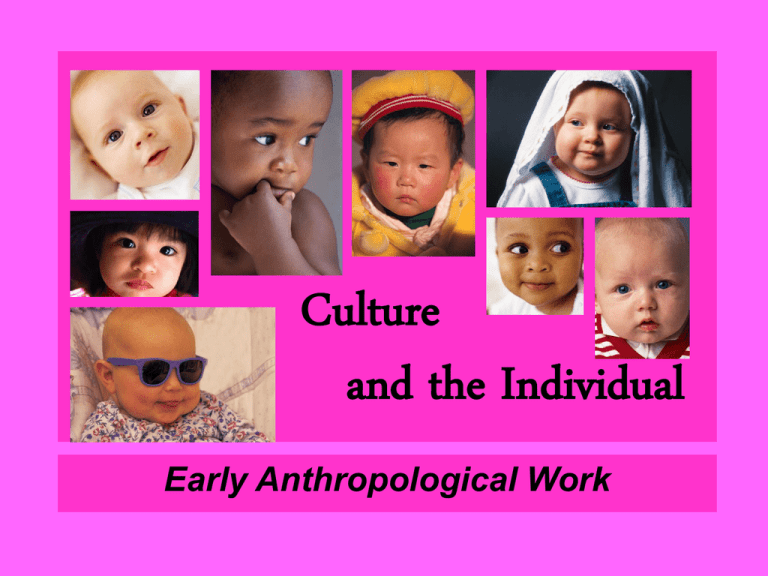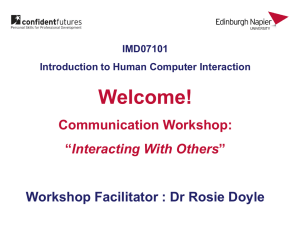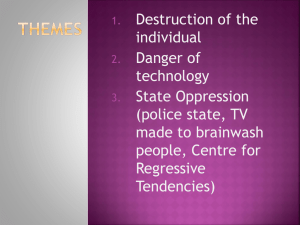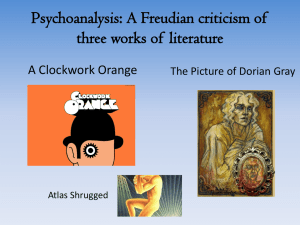
Culture
and the Individual
Early Anthropological Work
Racism and Stereotypes
There were two general approaches to
understanding diversity prior to the turn of the
twentieth century:
1. Individual characteristics are a result of innate
traits that are inherited from ancestors;
similarities between individuals within a society
are due to common ancestry = Racism
2. Individuals in a society are alike because they
grow up under the same cultural situations, and
can be described accurately using broad
stereotypes = National character stereotypes.
Eg. Emanuel Kant & Stereotypes
According to Kant (1789), Germans are:
Homeloving
Solid
Intelligent but lacking brilliance
Industrious
Cleanly
Capable
Lacking in wit
Lacking in taste
Overmethodical
Pedantic
Orderly
Docile under government
Early Work
Sigmund Freud
Bronislaw Malinowski
Margaret Mead
Edward Sapir
The New Freudians (Erikson, Gorer,
Roheim)
Abram Kardiner
Cora DuBois
Ruth Benedict
Freud: The Oedipal Complex
Boys are sexually attracted to their mothers.
Boys resent and are jealous of their father’s sexual
access to their mothers.
Boys also love their fathers and need their fathers
love, creating a love/hate relationship.
Boys dream about conflict with their fathers,
including murdering their fathers to gain sexual
access to their mothers.
Normal, healthy development demands that boys
resolve their jealousy and aggressive feelings
toward their fathers, and give up sexual
fantasies about their mothers.
Malinowski’s Challenge
Who: Bronislaw Malinowski
Where: The Trobriand Islands
What: A natural experiment
Concepts:
Patrilineality vs Matrilineality
Fathers vs Maternal Uncles
Sexuality vs Authority
Evidence vs Interpretation
The Trobriand Islands
What Is a Standard Kinship Diagram?
A standard kinship diagram has two of each type of
relative EGO can have, one that is male and one that is
female. As a result, standard kinship diagram does not
have the complexity of most real family diagrams. A
standard kinship diagram is shown below. Notice that
EGO’s parents each have two siblings, one sister and one
brother. Likewise each of these has two children, one
male and one female.
What is a Patrilineage?
The diagram below show all relatives in EGO’s
patrilineage in blue. Notice that if a person is in EGO’s
patrilineage, all siblings of that person are also in EGO’s
patrilineage. EGO’s mother is not part of his
patrilineage, nor are any of her family members. His
mother is part of another patrilineage that includes 3,
10, 12, 13, 23 and 24.
Patrilineal Inheritance of Property
The diagram below shows how property is typically
inherited in a patrilineal system. The blue lines show
how inheritance moves from one male individual in a
generation to male individuals in succeeding
generations.
What is a Matrilineage?
The diagram below show all relatives in EGO’s
matrilineage in pink. Notice that if a person is in EGO’s
matrilineage, all siblings of that person are also in
EGO’s patrilineage. EGO’s father is not part of his
matrilineage, nor are any of his family members. His
father is part of another matrilineage that includes 2, 6,
7, 9, 15 and 16.
Matrilineal Inheritance of Property
The diagram below shows how property is typically
inherited in a matrilineal system. Notice that females
are the links that connect men who will inherit. The
pink lines show how inheritance moves from one male
individual in a generation to male individuals in
succeeding generations. Women do not typically
manage property, even in a matrilineal system.
Mother’s Brother in Matrilineages
In matrilineal societies, EGO’s mother’s brother is a very
important relative, because he is the one who controls the
property that EGO will inherit. EGO is the mother’s brother of
his sister’s son(s).
EGO will therefore manage his matrilineage’s property for his
sister’s sons to inherit. EGO’s own children will not inherit from
him. They will inherit from their mother’s (EGO’s future wife’s)
brother(s).
Malinowski’s Findings
1.
•
•
•
•
•
•
•
•
From Sex and Repression in Savage Society
Trobrianders are well-adjusted and lacking in obvious
“perversions and neuroses.”
Boys reported no sexual dreams about mothers.
Boys reported some sexual dreams about sisters.
There are no Oedipal legends in Trobriand folklore.
Brother-sister incest is a recurring theme in Trobriand
folklore.
There is no reported mother-son incest.
Some brother-sister cases of incest are reported.
Boys reported no negative feelings toward fathers or
dreams about conflict with fathers; they reported warm,
loving relationships.
Boys reported hostility and hostile dreams involving their
maternal uncles.
Malinowski’s Conclusions
This society shows no evidence that would
support the presence of the Oedipal
Complex.
The absence of evidence for the Oedipal
Complex in Trobriand society means that it
cannot be a universal part of human male
development.
The Freudian Response
The Trobriand maternal uncle and sister
symbolized the father and the mother
respectively.
Anthropologists lacked the psychoanalytic
skill to identify the Oedipal Complex.
Denial in anthropologists caused them to
suppress recognition of the Oedipal
Complex.
Margaret Mead
The Nature of Adolescence in Samoa
Gender Differences in New Guinea
Child Development in Bali
Childhood Cognition in New Guinea
The South Pacific
Mead and Samoan Adolescence
American adolescence is a turbulent and
difficult time characterized by rebellion and
experimentation with sex.
Samoan adolescence is not a time of
rebellion and young people do not find the
transition to adulthood difficult. Sexuality
is not treated as a taboo subject in Samoa
and is not a source of rebellion.
Mead: Gender Differences
in New Guinea
Three different cultural groups in the Sepik region of New
Guinea:
Arapesh Society– both men and women were gentle, responsive and
cooperative.
Tchambuli Society– men were gentle and dependent while women
were dominant and impersonal.
Mundugumor Society– both men and women were aggressive, violent
and power seeking.
Western ideas about gender traits were contradicted by all three
societies, and therefore cannot be universal.
Indonesia
Mead: Childhood in Bali
Mead and her husband Gregory Bateson
using field notes, still photos and the first
use of film and participant drawings to
record culture.
Documented teaching and learning, and
child care such as bathing practices that
they believed shaped personality.
Mead: Childhood Cognition
Animism = the belief that objects, plants and animals have spirits and can take
purposeful action through this spirit. All things have a supernatural/magical
component.
In Western culture, children think animistically while adults do not.
In Pere Village on Manus in New Guinea adult belief systems were very animistic.
Mead hypothesized that children should also think animistically as Western children do.
35,000 children’s drawings were collected.
Children depicted realistic things in their drawings, not supernatural things and their
animistic thinking increased as they grew older.
This was the reverse of what happened in Western society, and therefore animistic
thinking in children was shown NOT to be a universal trait.
Edward Sapir
Early proponent of studying the relationship
between culture and personality through
“psycholinguistics”.
Hosted the first academic seminars on
culture and personality at Yale University
in 1930.
Believed that language was an influential
shaper of personality as grammatical
structures and vocabulary shape thought.
The Neo Freudians
Erik Erikson studied the impact of childrearing on adult personality in the Sioux.
Cradleboarding caused great frustration
that resulted in suppressed rage that
translated into adult cruelty, aggression, and
ritualized self torture for warriors.
Geoffrey Gorrer studied swaddling of Russian
peasant children resulting in generalized
rage combined with guilt for feelings against
parents that resulted in alcoholism and
religiosity.
The Neo Freudians
Geza Roheim used the Oedipal Complex to
explain agricultural practices.
- Trobriand boys jammed phallic shaped
yams into the earth in their frustration over
oedipal issues, and when yams grew, the
society began to plant food crops.
- Clearing forest for gardens with axes was
a metaphor for father castration.
- Egyptian ploughs “penetrated” the earth,
and the ox that was used to pull it was a
castrated animal.
Abram Kardiner
A Neo Freudian who dropped the Oedipal focus.
Inferred from cultural information that there was a
“basic personality structure” for every culture”
based on:
1. Primary Institutions = shape basic personality
structures (child rearing institutions that discipline,
inhibit, gratify children)
2. Secondary Institutions = result from basic
personality structures (religion, taboosystems,
rituals, folktales) and satisfy needs & tensions
created in the individual by primary institutions
and shape primary institutions.
Abram Kardiner
Cora DuBois
Fieldwork on Alor Island in Indonesia
Derived the concept of “modal personality” from
test data (most common personality traits).
Data was biographies, dreams, children’s drawings
and projective tests.
Blind analysis of projectives by two individuals.
Personality characteristics: suspicious, sneaky,
insecure, apathetic.
Babies abandoned in the village each day while
the mother goes to work in the fields, fed only
while the women were in village.
Ruth Benedict
Patterns of Culture (Southwestern Zuni,
Northwest Coast Kwakiutl, Melanesian
Dobu) Configurations of personality traits
The Chrysanthemum and the Sword
(Japanese) National Character










